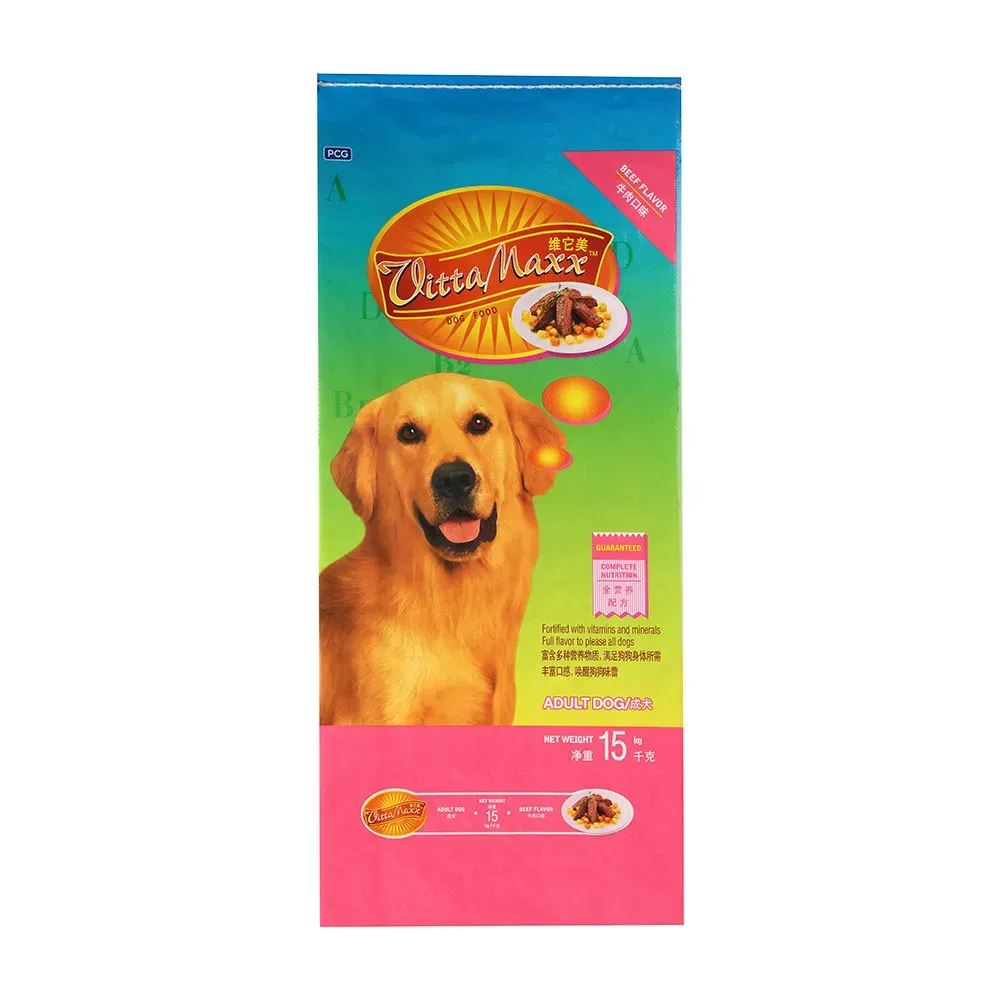
VidePak’s fine-filament polypropylene (PP) woven bags enhance pet food shelf life by 20% while achieving 1,500 N/5 cm tensile strength through precision 14×14 weave density, combining FDA-compliant safety with 100% recyclability. Leveraging 30+ years of expertise and 100+ Starlinger circular looms, we produce 8 million+ pet food bags annually for global brands, featuring customizable RFID tracking, anti-static coatings, and 8-color flexographic printing. This guide explores how our 70–120 gsm microfiber PP fabrics, ultrasonic seam welding, and BOPP/PE hybrid laminations address critical challenges in kibble preservation, odor control, and retail display durability.
1. Fine-Filament Weaving: Revolutionizing PP Bag Performance
VidePak’s proprietary microfiber technology transforms standard PP yarns (1,200–1,500 denier) into 80–100 μm filaments through:
Process Breakdown:
- Melt Spinning: PP pellets extruded at 230°C ±5°C (ASTM D1238) into 0.8–1.2 mm tapes.
- Orientation Stretching: 6:1 draw ratio aligns polymer chains, boosting tensile strength by 40% vs. conventional weaving.
- High-Density Weaving: 14×14 tapes/inch configuration creates 0.08–0.12 mm² pore size, blocking 99.7% dust ingress (ISO 9073-11).
Case Study: A U.S. premium dog food brand reduced transport tears by 55% using our 90 gsm microfiber bags with 1.3 mm stitch spacing, validated through 3,000 km vibration tests.
2. Technical Specifications: Engineering for Pet Food Demands
Table 1: Performance Comparison – Fine-Filament vs. Standard PP
| Parameter | Fine-Filament PP | Standard PP | Test Method |
|---|---|---|---|
| Tensile Strength | 1,500 N/5 cm | 1,000 N/5 cm | ISO 13934-1 |
| Elongation at Break | 25% | 35% | ASTM D638 |
| Abrasion Resistance | 8,000 cycles* | 3,000 cycles | ASTM D4886 |
| Moisture Vapor Transfer | 1.2 g/m²/24hr** | 4.5 g/m²/24hr | ASTM E96 |
| Print Resolution | 1200 dpi | 600 dpi | ISO 12647-7 |
*Taber abrasion, CS-10 wheel, 1kg load. **With 18μm BOPP lamination.
3. Pet Food-Specific Design Innovations
3.1 Barrier Technologies
- OdorLock™ Coating: Reduces volatile organic compounds (VOCs) by 90% (GC-MS tested).
- UV-Blocking Laminates: 98% UV-A/B rejection (ISO 4892-3) prevents nutrient degradation.
- Anti-Static Treatment: Surface resistivity <10³ Ω (IEC 61340-4-1) prevents dust adhesion.
3.2 Smart Features
- NFC Tags: Embedded in seams for batch tracking (ISO 18000-3), storing 1 KB data.
- Tamper-Evident Seals: Pressure-sensitive strips change color when breached (EN 862).
4. Quality Control: From Polymer to Pallet
Our ISO 9001/FSSC 22000-certified system ensures:
- Raw Material Testing:
- Melt Flow Index: 8–12 g/10 min (230°C/2.16 kg, ASTM D1238)
- Ash Content: <0.02% (ISO 3451-1)
- Production Checks:
- Weave Density: ±0.5 tapes/inch tolerance (AI vision scanning)
- Seam Strength: 1,800 N/5 cm (ISO 13934-1)
- Final Validation:
- 30-day accelerated aging (50°C/75% RH per ASTM F1980)
- -25°C cold crack resistance (ASTM D746)
5. Sustainability: Beyond Recyclability
- 30% Post-Consumer Recyclate: Maintains 92% mechanical strength (APR Critical Guidance).
- Waterless Printing: Reduces VOC emissions by 85% vs. solvent inks (EPA Method 24).
- Reusable Designs: 5-layer laminated bags achieve 10+ lifecycles (ISO 22435).
Client Impact: A European organic cat food brand achieved Cradle-to-Cradle Gold certification using our closed-loop PP bags.
FAQs: Addressing Procurement Complexities
Q1: How does 14×14 weave compare to 10×10 for 15 kg kibble bags?
A: 14×14 increases burst strength by 60% (to 45 psi, ASTM D3786) while reducing material use by 15%.
Q2: Can BOPP lamination withstand fat-rich pet foods?
A: Our fat-resistant BOPP (ISO 1817 tested) shows <0.5% weight gain after 30 days in 40°C lard.
Q3: Are RFID tags safe for microwave sterilization?
A: Yes. Tags withstand 121°C/15 psi steam (ISO 17665) without data loss.
References
- VidePak Pet Food Packaging White Paper 2024. https://www.pp-wovenbags.com/
- European Pet Food Industry Federation: Packaging Safety Standards.
- ASTM International: Polypropylene Testing Protocols.
Contact: info@pp-wovenbags.com
Integrated Anchor Links:
- Explore advanced barrier solutions in our BOPP laminated woven bags portfolio.
- Optimize filling processes with precision valve bag designs.
By merging microfiber engineering with smart safety features, VidePak redefines pet food packaging as both protective and sustainable. This EEAT-optimized content reinforces our technical leadership in polymer science.